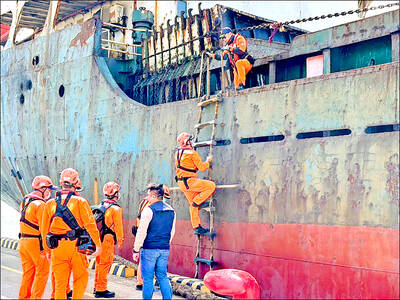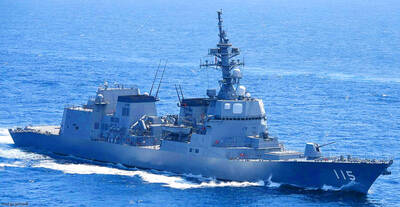Asian stocks fell this week, the third weekly decline in four, as concern the global recovery will falter caused commodity prices to drop and the yen to strengthen.
BHP Billiton Ltd, the world’s biggest mining company, dropped for a fifth week after copper and oil prices slumped. Honda Motor Co, which makes 51 percent of its revenue in North America, tumbled 10 percent on concern a stronger yen will hurt the value of its overseas revenue. STX Pan Ocean Co Ltd, South Korea’s biggest bulk carrier, sank 11 percent as shipping rates declined.
The MSCI Asia-Pacific Index lost 2.1 percent in the five days to Friday, adding to last week’s 0.8 percent decline. That pared the measure’s record 28 percent in the three months ended June 30 on optimism the global economy is stabilizing.
“The market is finally returning its focus to the present, rather than looking for an eventual recovery,” said Masaru Hamasaki, a Tokyo-based strategist at Toyota Asset Management Co, which oversees US$14 billion. “The economic rebound won’t be rapid. Share prices are beginning to reflect that.”
The Asian stock benchmark, which plunged by a record last year as the global economy slipped into recession, has now climbed 43 percent since reaching a more than five-year low on March 9. Stocks on the gauge now trade at 22.8 times reported earnings, compared with 15 times at the market trough in March and 14.9 for the US’ Standard & Poor’s 500 Index.
Taiwanese share prices are expected to consolidate next week as investors remain sidelined, looking for cues from the quarterly results of firms on Wall Street, dealers said on Friday.
Investors turned hesitant after a mixed performance dominated US markets, which failed to give a clear indication for future movements, they said.
Falling oil prices have prompted investors to take a cautious attitude toward a global economic recovery as demand remains weak, they added.
As a recent strong showing has pushed the index to move closer to the 6,800-6,900 range, stiff resistance may emerge next week, while technical support is expected at around 6,600 points, dealers said.
For the week to Friday, the TAIEX rose 104.46 points or 1.57 percent to 6,769.86 after a 3.12 percent increase a week earlier.
Average daily turnover stood at NT$119.37 billion (US$3.62 billion), compared with NT$107.42 billion the previous week.
“Institutional investors have started to take profit and run. If the market tests the 6,800-6,900 range, it could be another good chance for institutional investors to cut more holdings,” Concord Securities (康和證券) analyst Allen Lin said.
Before US stock heavyweights report second-quarter earnings later this month, investors are reluctant to trade on a lack of fresh hints, Lin said.
“I expect the market will be locked in see-saw trading with any gains to be immediately offset by profit-taking,” Lin said.
Other markets on Friday:
TOKYO: Flat. The Nikkei-225 dropped 3.78 points, or 0.04 percent, to 9,287.28 from Thursday.
HONG KONG: Down 0.46 percent. The Hang Seng Index ended down 82.17 points at 17,708.42.
SYDNEY: Up 0.82 percent. The S&P/ASX 200 was 30.8 points higher at 3,794.1.
SHANGHAI: Down 0.29 percent. The Shanghai Composite Index, which covers A and B shares, was down 9.10 points to 3,113.93.
SEOUL: Down 0.15 percent. The KOSPI lost 2.27 points to 1,428.62.
MUMBAI: Down 1.84 percent. The 30-share SENSEX fell 253.24 points to 13,504.22. Investors unwound positions ahead of the weekend, despite better-than-expected earnings from IT giant Infosys and higher industrial output, dealers said.

A Chinese freighter that allegedly snapped an undersea cable linking Taiwan proper to Penghu County is suspected of being owned by a Chinese state-run company and had docked at the ports of Kaohsiung and Keelung for three months using different names. On Tuesday last week, the Togo-flagged freighter Hong Tai 58 (宏泰58號) and its Chinese crew were detained after the Taipei-Penghu No. 3 submarine cable was severed. When the Coast Guard Administration (CGA) first attempted to detain the ship on grounds of possible sabotage, its crew said the ship’s name was Hong Tai 168, although the Automatic Identification System (AIS)

An Akizuki-class destroyer last month made the first-ever solo transit of a Japan Maritime Self-Defense Force ship through the Taiwan Strait, Japanese government officials with knowledge of the matter said yesterday. The JS Akizuki carried out a north-to-south transit through the Taiwan Strait on Feb. 5 as it sailed to the South China Sea to participate in a joint exercise with US, Australian and Philippine forces that day. The Japanese destroyer JS Sazanami in September last year made the Japan Maritime Self-Defense Force’s first-ever transit through the Taiwan Strait, but it was joined by vessels from New Zealand and Australia,

SECURITY: The purpose for giving Hong Kong and Macau residents more lenient paths to permanent residency no longer applies due to China’s policies, a source said The government is considering removing an optional path to citizenship for residents from Hong Kong and Macau, and lengthening the terms for permanent residence eligibility, a source said yesterday. In a bid to prevent the Chinese Communist Party (CCP) from infiltrating Taiwan through immigration from Hong Kong and Macau, the government could amend immigration laws for residents of the territories who currently receive preferential treatment, an official familiar with the matter speaking on condition of anonymity said. The move was part of “national security-related legislative reform,” they added. Under the amendments, arrivals from the Chinese territories would have to reside in Taiwan for

CRITICAL MOVE: TSMC’s plan to invest another US$100 billion in US chipmaking would boost Taiwan’s competitive edge in the global market, the premier said The government would ensure that the most advanced chipmaking technology stays in Taiwan while assisting Taiwan Semiconductor Manufacturing Co (TSMC, 台積電) in investing overseas, the Presidential Office said yesterday. The statement follows a joint announcement by the world’s largest contract chipmaker and US President Donald Trump on Monday that TSMC would invest an additional US$100 billion over the next four years to expand its semiconductor manufacturing operations in the US, which would include construction of three new chip fabrication plants, two advanced packaging facilities, and a research and development center. The government knew about the deal in advance and would assist, Presidential